Enchanting Garden Gates: Add a Delightful Detail to Your Lawn, Garden
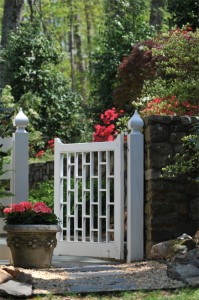 An ornamental garden gate could be just the irresistible design element your home needs to add that dose of unforgettable charm to its exterior. A garden gate is an architectural detail that alluringly hints at a secret garden or private oasis just on the other side of it. Enhancing your lawn with a delightful garden gate will be a visual treat that welcomes visitors and entices them to cross the threshold to your home.
An ornamental garden gate could be just the irresistible design element your home needs to add that dose of unforgettable charm to its exterior. A garden gate is an architectural detail that alluringly hints at a secret garden or private oasis just on the other side of it. Enhancing your lawn with a delightful garden gate will be a visual treat that welcomes visitors and entices them to cross the threshold to your home.
There’s a style of garden gate to suit every personality and every home’s exterior. You’ll find no shortage of details and adornments like cutouts, open ironwork and embellishments. It’s especially fun to search in antique shops to salvage a vintage gate and give it a new life at your home.
A garden gate offers a wonderful opportunity for seasonal decorations, too. Is anything more patriotic than swags of red, white and blue bunting and a spray of miniature flags displayed on an upright and proud garden gate? You can also enhance this focal point by adding playful color—either by painting it a fun color or by training ornamental vines to grow on it (especially if your gate has a pergola or arched arbor over top).
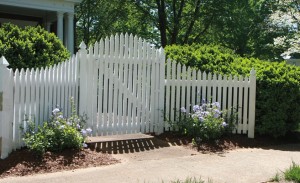 Look to your home’s already-established entry points to determine the best location for a new gate. Places like the end of the front walkway or between the driveway and your home’s side entrance are especially great places to install one. And remember: you don’t need an entire picket fence to add an element of cottage charm to your home. You can install a garden gate as a freestanding element, as long as there are two stout posts to support it. Maybe you have an existing gate within a fencerow, but you feel it lacks character; a new garden gate in this spot might just be the answer.
Look to your home’s already-established entry points to determine the best location for a new gate. Places like the end of the front walkway or between the driveway and your home’s side entrance are especially great places to install one. And remember: you don’t need an entire picket fence to add an element of cottage charm to your home. You can install a garden gate as a freestanding element, as long as there are two stout posts to support it. Maybe you have an existing gate within a fencerow, but you feel it lacks character; a new garden gate in this spot might just be the answer.
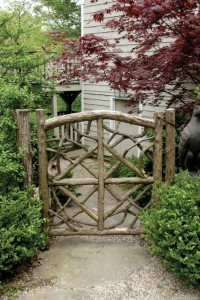 Step-by-Stepping Into a Garden Gate
Step-by-Stepping Into a Garden Gate
Now that you’re convinced your home needs a charming little gate, before you can go shopping, there are a few important tasks to which you must first attend. As with any home improvement project, there’s more to it than just finding an attractive gate that “speaks” to you.
Be sure to measure the space where the gate will be installed. A typical garden gate will fit either a 3- or 4-foot-wide opening, and most will stand at least 3 feet tall.
You’ll need to locate your underground utilities to make sure the spot you’ve chosen for your gate is suitable—after all, you’ll have to sink a pair of fence posts several inches into the ground in that place to support your new gate.
You might need to contact your local building department to determine if you need a permit to install a gate, or call your homeowner’s association or historic district association to verify your neighborhood’s requirements. After one final check of your property lines, you’re officially an informed shopper, armed with all the data you need to go looking for the perfect gate.
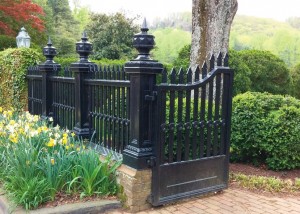 Bring it Home, Baby
Bring it Home, Baby
You’ve been trolling all your favorite antique shops, architectural salvage stores and landscaping supply companies, and narrowed your choices down to find just the right gate. It’s time to bring your new baby home and install it!
A great gate needs a good installation. It can be a do-it-yourself job for skilled homeowners, but a licensed professional will ensure the job’s done properly. Either way, this job needs more than one pair of hands to help keep everything steady and level—the key to a smoothly swinging gate.
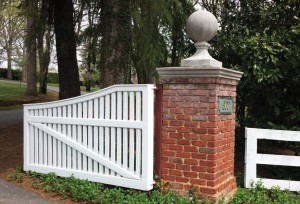 Have you thought about how you’d like the gate to swing—which direction makes the easiest entry and exit for you? Caring for your gate’s hinges is important because they distribute the weight of the gate on the fence post and support an even swing. Your gate will have at least two (and possibly three, depending on how heavy it is) hinges. Rust can be a concern with metal hinges and gates, so keep your gate rust-free and swinging smoothly by treating it with a lubricant on an annual basis. Late spring (after the last chance of frost) is a great time to do this simple maintenance task.
Have you thought about how you’d like the gate to swing—which direction makes the easiest entry and exit for you? Caring for your gate’s hinges is important because they distribute the weight of the gate on the fence post and support an even swing. Your gate will have at least two (and possibly three, depending on how heavy it is) hinges. Rust can be a concern with metal hinges and gates, so keep your gate rust-free and swinging smoothly by treating it with a lubricant on an annual basis. Late spring (after the last chance of frost) is a great time to do this simple maintenance task.
White lithium grease is a good choice for metal-to-metal joints like hinges and latches, because gate hinges need a clinging grease to repel water and hold up under ever-changing weather conditions. (Spray-on lubricants like WD-40 are good for light-duty lubrication, so use them as a supplemental helper, but don’t depend on them for your main source of lubrication for your outdoor hinges.) Keeping your new gate clean is easy—most will only need an occasional rinse with a hose.
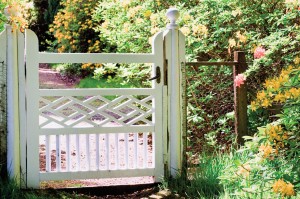 Many gates come with all the hardware they need—hinges and latches. But if yours doesn’t, you’ll need to decide if your gate requires the security measure of a latch. Some homeowners may be installing a garden gate purely as a decorative touch, but others may need their gate to help keep pets in the yard or to secure a safe play area for children. (Swimming pool enclosures require a completely different, very specific set of requirements, so absolutely consult your homeowner’s insurance policy and your swimming pool contractor when contemplating a gate around that unique area. Ornamental gates are not likely to be adequate for use near a swimming pool.)
Many gates come with all the hardware they need—hinges and latches. But if yours doesn’t, you’ll need to decide if your gate requires the security measure of a latch. Some homeowners may be installing a garden gate purely as a decorative touch, but others may need their gate to help keep pets in the yard or to secure a safe play area for children. (Swimming pool enclosures require a completely different, very specific set of requirements, so absolutely consult your homeowner’s insurance policy and your swimming pool contractor when contemplating a gate around that unique area. Ornamental gates are not likely to be adequate for use near a swimming pool.)
There are a number of different styles of gate locks available. Which one you choose will depend upon the type of gate you have and your personal taste.
If you’re concerned that your gate should close securely each time it’s used, the best type of lock is a spring latch. Spring latches have a tightly coiled spring that draws back as the gate is opened, and when released, snaps the latch back home to securely lock the gate. If you’d like to add an historic touch that dates back to colonial times to your gate, consider an old-fashioned cannonball “automatic” gate closer. The weight of the cannonball (attached to a chain secured to both the fencepost and the gate door) pulls the gate shut.
 If you are looking for an ornamental gate lock that can be easily operated from the inside or outside, a thumb latch is the one. They are available in a wide range of designs, and feature a simple mechanism that operates by depressing a small latch with the thumb. If you want a strong latch with the option of securing it with a padlock, consider a slide bolt, which operates by sliding a bolt attached to the gate into a bracket attached to the gatepost. If you want even more security, choose a lockable latch. Lockable latches need a key, and most will lock automatically when the gate is closed. They can be used on all types of gates, whether made of wood or metal.
If you are looking for an ornamental gate lock that can be easily operated from the inside or outside, a thumb latch is the one. They are available in a wide range of designs, and feature a simple mechanism that operates by depressing a small latch with the thumb. If you want a strong latch with the option of securing it with a padlock, consider a slide bolt, which operates by sliding a bolt attached to the gate into a bracket attached to the gatepost. If you want even more security, choose a lockable latch. Lockable latches need a key, and most will lock automatically when the gate is closed. They can be used on all types of gates, whether made of wood or metal.
If all this talk of latches and locks worries you that your new decorative garden gate could intimidate visitors and keep them away, remember it’s just a practical detail that reminds us our gates can help us be good neighbors—especially when we keep them low enough to allow communication across them and they swing freely open toward our home.
Garden Gates, Gate Hardware, Lawn Enhancement, Ornamental Gates, Secret Garden






